
The Australian state of Victoria issued revenue stamps from 1870 to around 2000. There were various types for different taxes. [1]

The Australian state of Victoria issued revenue stamps from 1870 to around 2000. There were various types for different taxes. [1]

The first beer duty stamps were issued for beer in kegs in 1880, and like issues for the other Australian states, most were damaged or destroyed in use so most existing examples are in mint condition. The second issue was in 1881, and stamps in similar designs for use on kegs or bottles were issued until 1906. In 1918, they were replaced by Australian Commonwealth beer duty issues.
All swine duty stamps were stamp duty revenues overprinted. Overprints exist on both numeral formats, and on both decimal stamps. There are a number of variations in the font of the overprints used.
From 1973 to 1981, a set of three hunting stamps with values of $2, $3 and $10, each portraying wild animals, was issued. These were replaced by a single numeral $5 value in 1982 and were withdrawn sometime later.
The only Motor Transfer stamp was a Queen Victoria stamp duty 2s6d overprinted with a curved MOTOR TRANSFER. It is quite common.
The only two stamps were diamond-shaped stamps without any value issued in purple or blue.
Three sets of relief tax stamps were issued, all in 1930. The first two sets were specially inscribed stamps with a difference in perforation, while the second set consisted of overprints on contemporary stamp duty issues.
The first set had thirty one values ranging from 1d to £100 and was also valid for postage. Most later stamps until 1904 were also valid for postage and they portrayed Queen Victoria. Numerals were introduced in 1904 and these remained in use, either in large or small format, until the 1960s. In 1966 a decimal set was issued and in 1981 a second decimal set was issued in a more modern format on gloss paper and with perforation 13.5 by 13. Later issues of this format were issued on matte paper and a reduced range of values were issued on both gloss paper and matte paper with perforation 11 by 11. Circa 1996 a new format was issued with roulette 14 separation. Circa 1997 a new format was issued with roulette 4.5 separation. In addition a new $10 of the 1981 format was issued circa 1994 with the $ symbol of the $10 aligning with the left border of the map of Victoria - to date, these being observed perforation 13.5 by 13 on effervescent gloss paper and perforation 11 on matte paper.
For visual examples of the above stamp formats please go to: "oz revenues.com" - "Research Analysis & Odd Items" - "Adhesive Duty Stamps of Victoria in the Decimal era".
By 2005 all stamp duties for which payment could be evidenced by the affixing of duty stamps had been abolished in the State of Victoria and the printing of Duty Stamps had ceased by 2005.
Special stamps for Duly Stamped and Exempt were also issued in the late 19th and early 20th centuries.
All stamp statute issues portrayed Queen Victoria. Two sets were issued between 1870 and 1882 and they were gradually replaced by stamp duty revenues.
All swine duty stamps were stamp duty revenues overprinted. Overprints exist on the early types, both numeral formats, and on decimal stamps.
The first Tax Instalment stamps were issued in 1933 by overprinting contemporary relief tax and stamp duty stamps with the appropriate wording. Later that year an inscribed set was issued and this design was first overprinted NOT TRANSFERABLE in 1936 and in 1938 a set was issued with a revised inscription. In 1941, the keytype used in all Australian states was issued overprinted VIC below the value. Thirty values ranging from 1d to £5 were issued.

The first revenue stamps in the United States were used briefly during colonial times, among the most notable usage involved the Stamp Act. Long after independence, the first revenue stamps printed by the United States government were issued in the midst of the American Civil War, prompted by the urgent need to raise revenue to pay for the great costs it incurred. After the war ended however, revenue stamps and the taxes they represented still continued. Revenue stamps served to pay tax duties on items that came under two main categories, Proprietary and Documentary. Proprietary stamps paid tax duties on goods like alcohol and tobacco, and were also used for various services, while Documentary stamps paid duties on legal documents, mortgage deeds, stocks and a fair number of other legal dealings. Proprietary and Documentary stamps often bore these respective designations, while in several of the issues they shared the same designs, sometimes with minor variations. Beginning in 1862 the first revenue stamps were issued, and would continue to be used for another hundred years and more. For the first twelve years George Washington was the only subject featured on U.S. revenue stamps, when in 1875 an allegorical figure of Liberty finally appeared. Revenue stamps were printed in many varieties and denominations and are widely sought after by collectors and historians. Revenue stamps were finally discontinued on December 31, 1967.

Revenue stamps of Malta were first issued in 1899, when the islands were a British colony. From that year to 1912, all revenue issues were postage stamps overprinted accordingly, that was either done locally or by De La Rue in London. Postage stamps also became valid for fiscal use in 1913, so no new revenues were issued until 1926–30, when a series of key type stamps depicting King George V were issued. These exist unappropriated for use as general-duty revenues, or with additional inscriptions indicating a specific use; Applications, Contracts, Registers or Stocks & Shares. The only other revenues after this series were £1 stamps depicting George VI and Elizabeth II. Postage stamps remained valid for fiscal use until at least the 1980s.

Revenue stamps of the United Kingdom refer to the various revenue or fiscal stamps, whether adhesive, directly embossed or otherwise, which were issued by and used in the Kingdom of England, the Kingdom of Great Britain, the United Kingdom of Great Britain and Ireland and the United Kingdom of Great Britain and Northern Ireland, from the late 17th century to the present day.
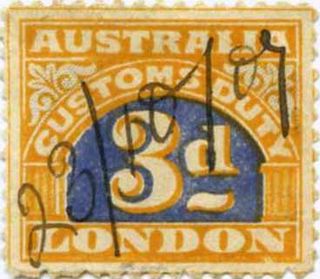
Australia issued revenue stamps from 1907 to 1994. There were various types for different taxes. In addition to Commonwealth issues, the states of New South Wales, Queensland, South Australia, Tasmania, Victoria and Western Australia as well as the territories Australian Capital Territory, North Australia and Northern Territory also had their own stamps.
The Australian state of Western Australia issued revenue stamps from 1881 to 1973. There were various types for different taxes.
The Australian state of Tasmania issued adhesive revenue stamps from 1863 to 1998, although impressed stamps had appeared briefly in the 1820s. There were general revenue and stamp duty issues, as well as a number of specific issues for various taxes.

The Australian state of South Australia issued revenue stamps from 1894 to 2003. There were various types for different taxes.

The Australian state of Queensland issued revenue stamps from 1866 to 1988. There were various types for different taxes.
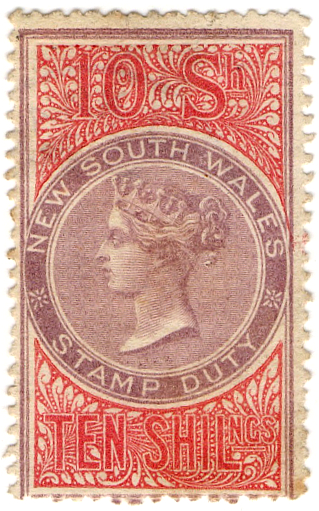
The Australian state of New South Wales issued revenue stamps from 1865 to 1998. There were various types for different taxes.
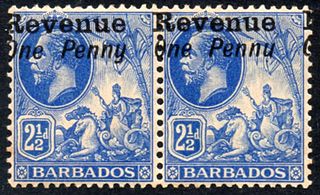
The island of Barbados first issued revenue stamps in 1916. There were various types of fiscal stamps for different taxes.

The South African Republic (ZAR), later known as Transvaal issued revenue stamps from 1875 to around 1950. There were a number of different stamps for several taxes.
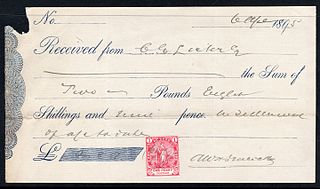
Cape of Good Hope issued revenue stamps from 1864 to 1961. There were a number of different stamps for several taxes.

New Zealand first issued revenue stamps on 1 January 1867 and their general use continued until the early 1950s. The only Revenue Stamp series still in use today is the Game Bird Habitat stamp which is used for payment of the Gun License for the duck shooting season which begins the first weekend of May. There were various types of fiscal stamps for different taxes.
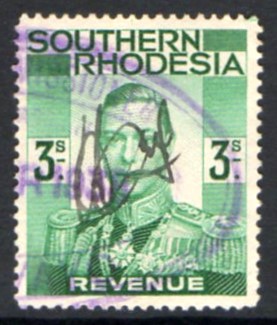
Rhodesia, now divided between Zambia and Zimbabwe, first issued revenue stamps in 1890, and Zimbabwe continues to do so to this day.
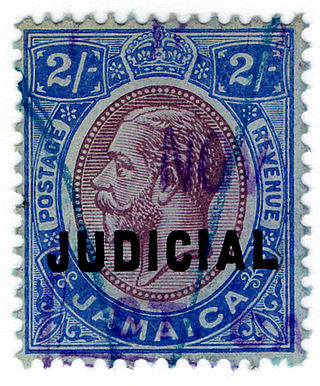
Revenue stamps of Jamaica were first issued in 1855. There were various types of fiscal stamps for different taxes.

Hong Kong issued revenue stamps from 1867 to the 1990s, both when it was a British colony as well as when it was under Japanese occupation.
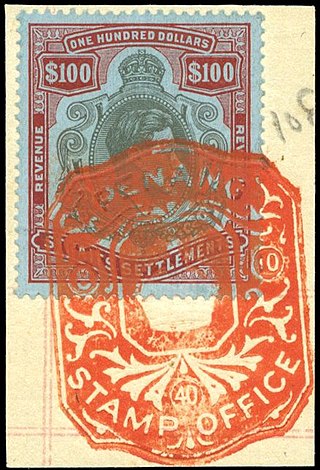
Malaysia first issued revenue stamps as the Straits Settlements in 1863, and continues to do so to this day. Over the years, a number of entities in modern Malaysia have issued revenue stamps.
Revenue stamps of Fiji were first issued in 1871 or 1872, when the Fiji islands were an independent kingdom. The first revenue stamps consisted of postage stamps overprinted with the letter D.

Revenue stamps of Hawaii were first issued in late 1876 by the Kingdom of Hawaii to pay taxes according to the Stamp Duty Act of 1876, although embossed revenue stamps had been introduced decades earlier in around 1845. The stamps issued in 1876–79 were used for over three decades, remaining in use during the Provisional Government, the Republic and after Hawaii became a U.S. Territory. Some changes were made along the years: from rouletted to perforated, and some new values, colours, designs and overprints were added. Some postage stamps were briefly valid for fiscal use in 1886–88 to pay for a tax on opium imports, and a stamp in a new design was issued for customs duties in 1897. A liquor stamp was issued in 1905.
Few revenue stamps of Nigeria and its predecessor states have been issued, since most of the time dual-purpose postage and revenue stamps were used for fiscal purposes. The first revenue-only stamps were consular stamps of the Niger Coast Protectorate and the Southern Nigeria Protectorate, which were created by overprinting postage stamps in 1898 and 1902 respectively. The Northern Nigeria Protectorate did not issue any specific revenue stamps, but a £25 stamp of 1904 could not be used for postal purposes due to its extremely high face value.